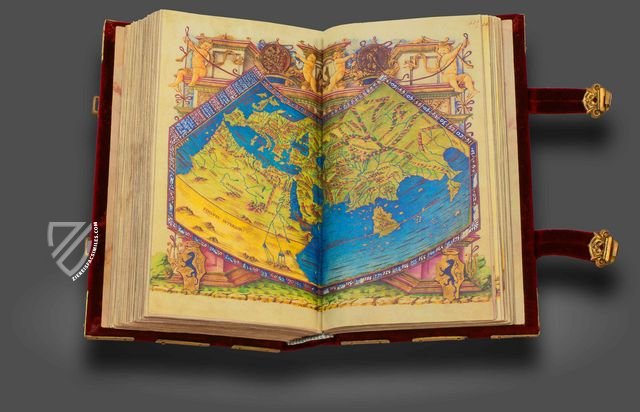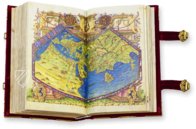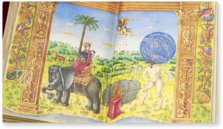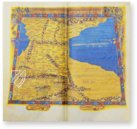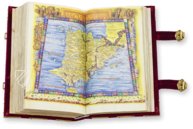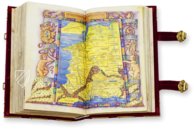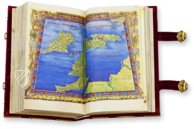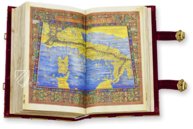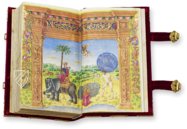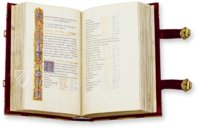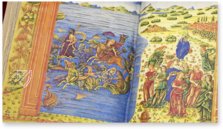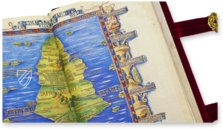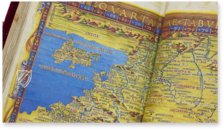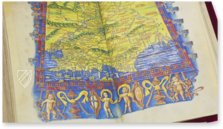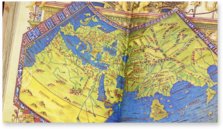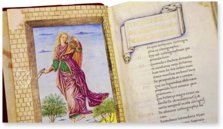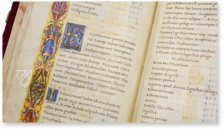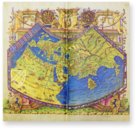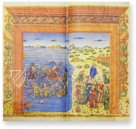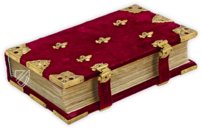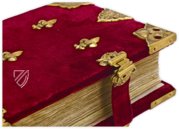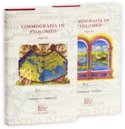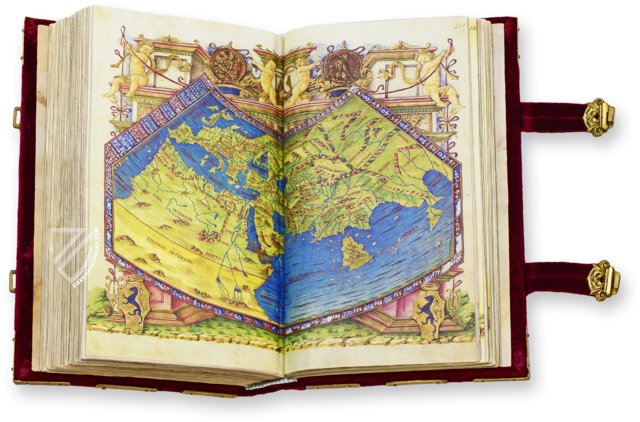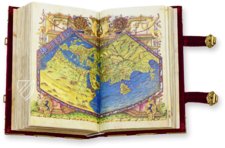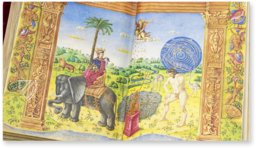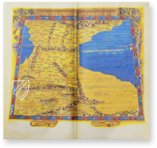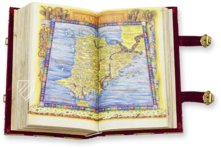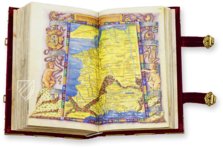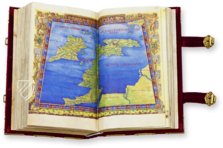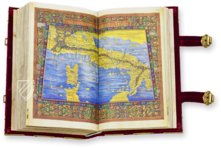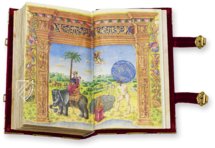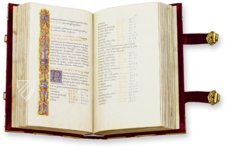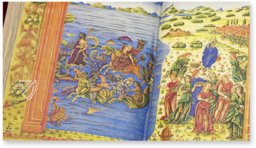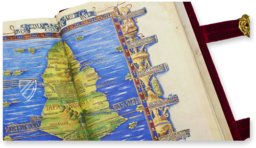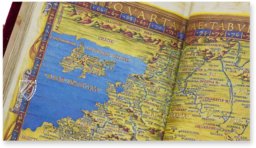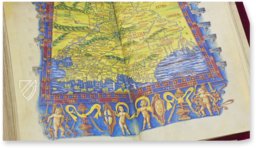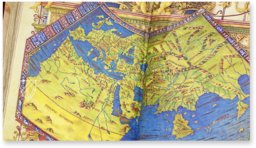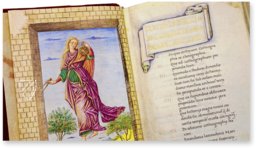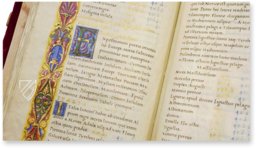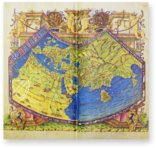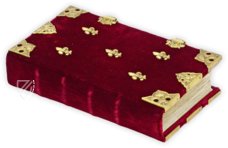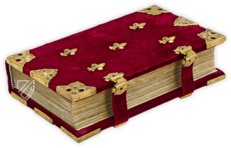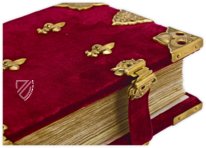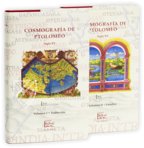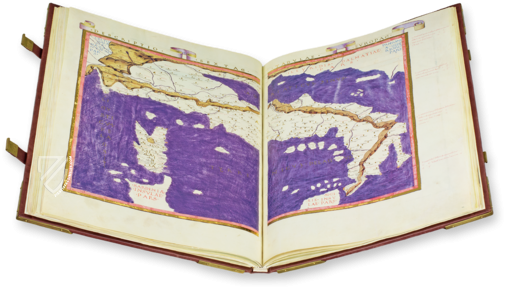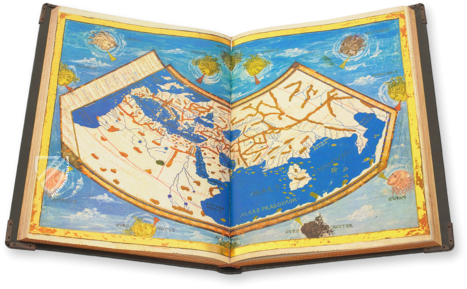Ptolemy Cosmography
(7,000€ - 10,000€)
The famous geographic work by Claudius Ptolemy, known by the Latin name Cosmographia, was a groundbreaking work of the 2nd century. Lost for 1,000 years, it was first rediscovered during the time of the Italian Renaissance and frequently adapted. One of the most beautiful specimens of the Cosmographia by Claudius Ptolemy is stored today in the French National Library in Paris. It arose ca. 1490 in Naples at the behest of Andrea Matteo III Acquaviva and, totally in the spirit of the Renaissance, enchants with its wonderful charts and overwhelming pictorial adornment. Something special about it is its unusually small format for a geographical work. The Parisian Codex of the Ptolemy Cosmography offers the wonderful opportunity to get to know both the groundbreaking scientific findings of Ptolemy and the great art of the Italian Renaissance!
Ptolemy Cosmography
The famous geographic work by Claudius Ptolemy, known by the Latin name Cosmographia, was a groundbreaking work of the 2nd century. Lost for 1,000 years, it was first rediscovered during the time of the Italian Renaissance and frequently adapted. One of the most beautiful specimens of the Cosmographia by Claudius Ptolemy is stored today in the French National Library in Paris. It arose ca. 1490 in Naples at the behest of Andrea Matteo III Acquaviva and, totally in the spirit of the Renaissance, enchants with its wonderful charts and overwhelming pictorial adornment. Something special about it is its unusually small format for a geographical work. The Parisian Codex of the Ptolemy Cosmography offers the wonderful opportunity to get to know both the groundbreaking scientific findings of Ptolemy and the great art of the Italian Renaissance!
A Grandiose Discovery
Claudius Ptolemy (ca. 100–170) was a Greek Renaissance man, who occupied himself as a mathematician, geographer, astronomer, philosopher, as well as in other disciplines. His scientific findings were to a large extent groundbreaking and forward-looking. As the composer of numerous standard works, the famous star catalog Almagest among them, he remained influential for centuries thereafter. The fascination with his findings still delighted scholars in the 14th century as his famous Cosmographia was rediscovered. The term cosmography denoted a description of the Earth and the universe, encompassing the scientific findings of geography, geology, astronomy, and astrology in connection with all aspects of the medieval world view. Lost and forgotten since the 2nd century, this Lost and forgotten since the 2nd century, this Ptolemaic geography was translated into Latin by Jacopo Angelo in Italy during the Renaissance, extensively received, and manifested itself frequently in the art of illumination.
A Ducal Commissioner
Andrea Matteo III Acquaviva, the famous Duke of Atri, was the one who commissioned one of the most fascinating of these splendid editions of the Cosmographia at the end of the 15th century. Andrea Matteo III Acquaviva originated from one of the most influential noble families in the Kingdom of Naples. As a bibliophile and lover of books he was simultaneously inquisitive of and attached to fine art. He wanted an atlas that was easy to use because of its unusually small format of 26 x 14 cm. Yet this edition of the Cosmographia is more of a luxury object or a collector’s piece than a scientific tool because of its lavish decoration.
The Great Art of the Renaissance in Naples
Bernardo Silvano d'Eboli, an Italian geographer and humanist resident of Naples, was contracted as the artist by Acquaviva. By trusting in the ability of the artist from his home of Naples, he was not following the contemporary taste, which was characterized above all by Florence. Bernardo Silvano adorned the Cosmographia with overwhelming miniatures of the highest quality. The book contains, among others, a gorgeous personification of geography and a depiction of Ptolemy. Grandiose decorative frames surround the colorful miniatures designed with great attention to detail. The heraldry of the Acquaviva family is often incorporated into the ornamental adornment. Splendid golden initials round out the outward appearance.
Cartographical Artwork
The artistically exceptional section of the book can nonetheless be found at the end: the marvelous maps. Always double-paged and framed, the cartographic section of the Cosmographia contains a world map and 26 more of individual continents, regions, and lands. Three allegorical depictions of the three then-known continents accompany the maps. The splendor of this small format atlas also enchanted Francois I, the French King (1494–1547), in whose possession the Cosmographia finally came and through whom it is still counted among the great treasures of the Bibliothèque Nationale de France today.
Codicology
- Alternative Titles
- Le petit Ptolomeo
Claudii Ptolomei Cosmographiae
Cosmografía de Claudio Ptolomeo
Cosmographia des Claudius Ptolemäus
Ptolemy Atlas
Atlante di Tolomeo
Claudius Ptolemaeus, Cosmographia - Size / Format
- 592 pages / 26.7 × 14.5 cm
- Origin
- Italy
- Date
- Ca. 1490
- Epochs
- Style
- Genre
- Language
- Content
- Treatise on cartography by Claudius Ptolemy
- Patron
- Andrea Matteo III Acquaviva, 8th Duke of Atri (1458–1529)
- Artist / School
- Bernardo Silvano d'Eboli workshop
- Previous Owners
- King Francis I of France (1494–1547)
Ptolemy Cosmography
Allegorical Table
Part of a double-page with an architectural frame, this miniature shows a female figure riding a crocodile, whip in hand, in front of a river landscape. This manuscript is more than just a work of geography – it is also filled with artistic depictions to excite the fascination of the beholder. The detail of this image is remarkable from the ferocious countenance and jagged teeth of the crocodile to the strings that attach the woman’s sandals to her feet.

Ptolemy Cosmography
World Map
Presented in the unusually small format of a manuscript intended for personal use, this depiction of the known world represents the most advanced state of geographic knowledge in Europe just before the discovery of the Americas. Furthermore, its outstanding quality makes it a fine example of the artistic refinement of the Italian Renaissance.
As with the other 26 maps in the codex, this world map is presented within a grandiose decorative frame consisting of classical architecture, cherubs, and the Acquaviva family coat of arms. This image is a splendid mix of artistry and science: the finest pigments were used to create the most accurate depiction possible, including shimmering silver ink to mark the degrees for calculating coordinates.
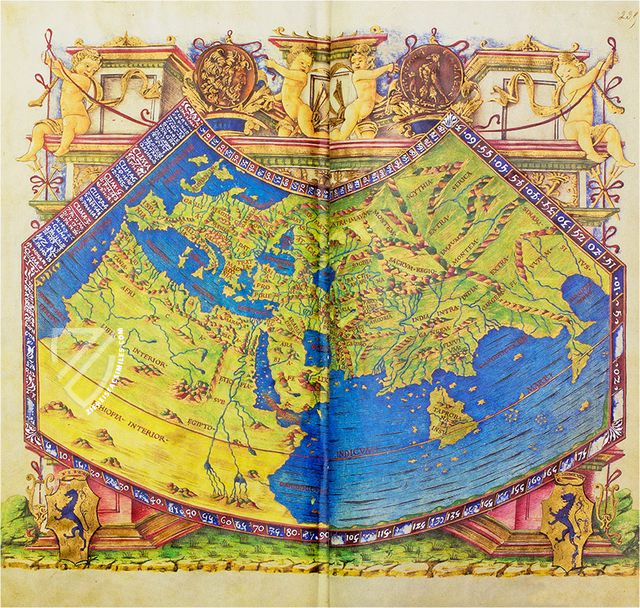
#1 Le petit Ptolomeo - Claudii Ptolomei Cosmographiae
Language: Spanish
(7,000€ - 10,000€)
- Treatises / Secular Books
- Apocalypses / Beatus
- Astronomy / Astrology
- Bestiaries
- Bibles / Gospels
- Chronicles / History / Law
- Geography / Maps
- Saints' Lives
- Islam / Oriental
- Judaism / Hebrew
- Single Leaf Collections
- Leonardo da Vinci
- Literature / Poetry
- Liturgical Manuscripts
- Medicine / Botany / Alchemy
- Music
- Mythology / Prophecies
- Psalters
- Other Religious Books
- Games / Hunting
- Private Devotion Books
- Other Genres
- Afghanistan
- Armenia
- Austria
- Belgium
- Belize
- Bosnia and Herzegovina
- China
- Colombia
- Costa Rica
- Croatia
- Cyprus
- Czech Republic
- Denmark
- Egypt
- El Salvador
- Ethiopia
- France
- Germany
- Greece
- Guatemala
- Honduras
- Hungary
- India
- Iran
- Iraq
- Israel
- Italy
- Japan
- Jordan
- Kazakhstan
- Kyrgyzstan
- Lebanon
- Liechtenstein
- Luxembourg
- Mexico
- Morocco
- Netherlands
- Palestine
- Panama
- Peru
- Poland
- Portugal
- Romania
- Russia
- Serbia
- Spain
- Sri Lanka
- Sweden
- Switzerland
- Syria
- Tajikistan
- Turkey
- Turkmenistan
- Ukraine
- United Kingdom
- United States
- Uzbekistan
- Vatican City
- A. Oosthoek, van Holkema & Warendorf
- Aboca Museum
- Ajuntament de Valencia
- Akademie Verlag
- Akademische Druck- u. Verlagsanstalt (ADEVA)
- Aldo Ausilio Editore - Bottega d’Erasmo
- Alecto Historical Editions
- Alkuin Verlag
- Almqvist & Wiksell
- Amilcare Pizzi
- Andreas & Andreas Verlagsbuchhandlung
- Archa 90
- Archiv Verlag
- Archivi Edizioni
- Arnold Verlag
- ARS
- Ars Magna
- ArtCodex
- AyN Ediciones
- Azimuth Editions
- Badenia Verlag
- Bärenreiter-Verlag
- Belser Verlag
- Belser Verlag / WK Wertkontor
- Benziger Verlag
- Bernardinum Wydawnictwo
- BiblioGemma
- Biblioteca Apostolica Vaticana (Vaticanstadt, Vaticanstadt)
- Bibliotheca Palatina Faksimile Verlag
- Bibliotheca Rara
- Boydell & Brewer
- Bramante Edizioni
- Bredius Genootschap
- Brepols Publishers
- British Library
- C. Weckesser
- Caixa Catalunya
- Canesi
- CAPSA, Ars Scriptoria
- Caratzas Brothers, Publishers
- Carus Verlag
- Casamassima Libri
- Centrum Cartographie Verlag GmbH
- Chavane Verlag
- Christian Brandstätter Verlag
- Circulo Cientifico
- Club Bibliófilo Versol
- Club du Livre
- CM Editores
- Collegium Graphicum
- Collezione Apocrifa Da Vinci
- Comissão Nacional para as Comemorações dos Descobrimentos Portugueses
- Coron Verlag
- Corvina
- CTHS
- D. S. Brewer
- Damon
- De Agostini/UTET
- De Nederlandsche Boekhandel
- De Schutter
- Deuschle & Stemmle
- Deutscher Verlag für Kunstwissenschaft
- DIAMM
- Droz
- E. Schreiber Graphische Kunstanstalten
- Ediciones Boreal
- Ediciones Grial
- Ediclube
- Edições Inapa
- Edilan
- Editalia
- Edition Deuschle
- Edition Georg Popp
- Edition Leipzig
- Edition Libri Illustri
- Editiones Reales Sitios S. L.
- Éditions de l'Oiseau Lyre
- Editions Medicina Rara
- Editorial Casariego
- Editorial Mintzoa
- Editrice Antenore
- Editrice Velar
- Edizioni Edison
- Egeria, S.L.
- Eikon Editores
- Electa
- Emery Walker Limited
- Enciclopèdia Catalana
- Eos-Verlag
- Ephesus Publishing
- Ernst Battenberg
- Eugrammia Press
- Extraordinary Editions
- Fackelverlag
- Facsimila Art & Edition
- Facsimile Editions Ltd.
- Facsimilia Art & Edition Ebert KG
- Faksimile Verlag
- Feuermann Verlag
- Folger Shakespeare Library
- Franco Cosimo Panini Editore
- Friedrich Wittig Verlag
- Fundación Hullera Vasco-Leonesa
- G. Braziller
- Gabriele Mazzotta Editore
- Gebr. Mann Verlag
- Gesellschaft für graphische Industrie
- Getty Research Institute
- Giovanni Domenico de Rossi
- Giunti Editore
- Graffiti
- Grafica European Center of Fine Arts
- Guido Pressler
- Guillermo Blazquez
- Gustav Kiepenheuer
- H. N. Abrams
- Harrassowitz
- Harvard University Press
- Helikon
- Hendrickson Publishers
- Henning Oppermann
- Herder Verlag
- Hes & De Graaf Publishers
- Hoepli
- Holbein-Verlag
- Houghton Library
- Hugo Schmidt Verlag
- Idion Verlag
- Il Bulino, edizioni d'arte
- ILte
- Imago
- Insel Verlag
- Insel-Verlag Anton Kippenberger
- Instituto de Estudios Altoaragoneses
- Instituto Nacional de Antropología e Historia
- Introligatornia Budnik Jerzy
- Istituto dell'Enciclopedia Italiana - Treccani
- Istituto Ellenico di Studi Bizantini e Postbizantini
- Istituto Geografico De Agostini
- Istituto Poligrafico e Zecca dello Stato
- Italarte Art Establishments
- Jan Thorbecke Verlag
- Johnson Reprint Corporation
- Josef Stocker
- Josef Stocker-Schmid
- Jugoslavija
- Karl W. Hiersemann
- Kasper Straube
- Kaydeda Ediciones
- Kindler Verlag / Coron Verlag
- Kodansha International Ltd.
- Konrad Kölbl Verlag
- Kurt Wolff Verlag
- La Liberia dello Stato
- La Linea Editrice
- La Meta Editore
- Lambert Schneider
- Landeskreditbank Baden-Württemberg
- Leo S. Olschki
- Les Incunables
- Liber Artis
- Library of Congress
- Libreria Musicale Italiana
- Lichtdruck
- Lito Immagine Editore
- Lumen Artis
- Lund Humphries
- M. Moleiro Editor
- Maison des Sciences de l'homme et de la société de Poitiers
- Manuscriptum
- Martinus Nijhoff
- Maruzen-Yushodo Co. Ltd.
- MASA
- Massada Publishers
- McGraw-Hill
- Metropolitan Museum of Art
- Militos
- Millennium Liber
- Müller & Schindler
- Nahar - Stavit
- Nahar and Steimatzky
- National Library of Wales
- Neri Pozza
- Nova Charta
- Oceanum Verlag
- Odeon
- Orbis Mediaevalis
- Orbis Pictus
- Österreichische Staatsdruckerei
- Oxford University Press
- Pageant Books
- Parzellers Buchverlag
- Patrimonio Ediciones
- Pattloch Verlag
- PIAF
- Pieper Verlag
- Plon-Nourrit et cie
- Poligrafiche Bolis
- Presses Universitaires de Strasbourg
- Prestel Verlag
- Princeton University Press
- Prisma Verlag
- Priuli & Verlucca, editori
- Pro Sport Verlag
- Propyläen Verlag
- Pytheas Books
- Quaternio Verlag Luzern
- Reales Sitios
- Recht-Verlag
- Reichert Verlag
- Reichsdruckerei
- Reprint Verlag
- Riehn & Reusch
- Roberto Vattori Editore
- Rosenkilde and Bagger
- Roxburghe Club
- Salerno Editrice
- Saltellus Press
- Sandoz
- Sarajevo Svjetlost
- Schöck ArtPrint Kft.
- Schulsinger Brothers
- Scolar Press
- Scrinium
- Scripta Maneant
- Scriptorium
- Shazar
- Siloé, arte y bibliofilia
- SISMEL - Edizioni del Galluzzo
- Sociedad Mexicana de Antropología
- Société des Bibliophiles & Iconophiles de Belgique
- Soncin Publishing
- Sorli Ediciones
- Stainer and Bell
- Studer
- Styria Verlag
- Sumptibus Pragopress
- Szegedi Tudomànyegyetem
- Taberna Libraria
- Tarshish Books
- Taschen
- Tempus Libri
- Testimonio Compañía Editorial
- Thames and Hudson
- The Clear Vue Publishing Partnership Limited
- The Facsimile Codex
- The Folio Society
- The Marquess of Normanby
- The Richard III and Yorkist History Trust
- Tip.Le.Co
- TouchArt
- TREC Publishing House
- TRI Publishing Co.
- Trident Editore
- Tuliba Collection
- Typis Regiae Officinae Polygraphicae
- Union Verlag Berlin
- Universidad de Granada
- University of California Press
- University of Chicago Press
- Urs Graf
- Vallecchi
- Van Wijnen
- VCH, Acta Humaniora
- VDI Verlag
- VEB Deutscher Verlag für Musik
- Verlag Anton Pustet / Andreas Verlag
- Verlag Bibliophile Drucke Josef Stocker
- Verlag der Münchner Drucke
- Verlag für Regionalgeschichte
- Verlag Styria
- Vicent Garcia Editores
- W. Turnowski Ltd.
- W. Turnowsky
- Waanders Printers
- Wiener Mechitharisten-Congregation (Wien, Österreich)
- Wissenschaftliche Buchgesellschaft
- Wissenschaftliche Verlagsgesellschaft
- Wydawnictwo Dolnoslaskie
- Xuntanza Editorial
- Zakład Narodowy
- Zollikofer AG

